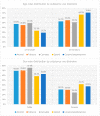Conduct Disorder-Related Hospitalization and Substance Use Disorders in American Teens
- PMID: 31284404
- PMCID: PMC6680533
- DOI: 10.3390/bs9070073
Conduct Disorder-Related Hospitalization and Substance Use Disorders in American Teens
Abstract
Objective: Our study aimed to compare the demographic characteristics of conduct disorder (CD) inpatients versus other psychiatric inpatients in children and adolescents, and assess the association between conduct disorder patients and the spectrum of substance use disorders (SUD).
Methods: We included 800,614 psychiatric adolescent (12-18 years) inpatients, and this included 8885 inpatients (1.1%) primarily for conduct disorder in the Nationwide Inpatient Sample (2010-2014). ICD-9 codes were used to detect SUD, and a logistic regression model was used to evaluate the odds ratio (OR) for SUD in conduct disorder inpatients.
Results: A higher proportion of conduct disorder inpatients were of 12-15 years of age (62.6%), male (64.4%), and White (45.7%). The lower median household income was correlated with a higher prevalence of conduct disorder (36.4%). Among SUD, cannabis use (23.7%) was most prevalent in conduct disorder inpatients followed by tobacco and alcohol use (10.1% each). Conduct disorder inpatients have 1.7-fold higher odds (95% confidence interval (CI) 1.52-1.82) for alcohol use and 1.4-fold higher odds (95% CI 1.31-1.49) for cannabis use compared to the non-conduct disorder inpatients. Cannabis use was seen significantly in adolescents (49.1%, 12-15 years), male (75.6%), and African Americans (45.6%).
Conclusion: Conduct disorder inpatients have a higher risk of comorbid SUD compared to other psychiatric illnesses. The most common substance to be abused is cannabis followed by tobacco and alcohol. Varying pattern of substance use was seen by demographics and these predictors may help the clinicians for early diagnosis and treatment to improve overall health-related quality of life.
Keywords: adolescents; alcohol abuse; cannabis abuse; conduct disorder; hospitalization; opioid abuse; substance use disorder.
Conflict of interest statement
The authors report no conflict of interest.
Figures
Similar articles
-
Alcohol Use Disorder Increases Risk of Traumatic Brain Injury-Related Hospitalization: Insights From 3.8 Million Children and Adolescent Inpatients.Cureus. 2020 Jun 21;12(6):e8740. doi: 10.7759/cureus.8740. Cureus. 2020. PMID: 32714678 Free PMC article.
-
Substance Use Disorders (SUD) and Suicidal Behaviors in Adolescents: Insights From Cross-Sectional Inpatient Study.Cureus. 2021 Jun 11;13(6):e15602. doi: 10.7759/cureus.15602. eCollection 2021 Jun. Cureus. 2021. PMID: 34277223 Free PMC article.
-
Recreational Cannabis Use and Risk of Prescription Opioid Overdose: Insights from Pediatric Inpatients.Cureus. 2020 Oct 20;12(10):e11058. doi: 10.7759/cureus.11058. Cureus. 2020. PMID: 33224654 Free PMC article.
-
Substance Use Disorders in Patients With Parkinson's Disease and Adverse Hospitalization Outcomes: A National Inpatient Study.Cureus. 2021 Jun 29;13(6):e16033. doi: 10.7759/cureus.16033. eCollection 2021 Jun. Cureus. 2021. PMID: 34336520 Free PMC article.
-
Rates of Dual Diagnosis in Child and Adolescent Psychiatric Inpatients: A Scoping Review.J Addict Med. 2022 Jan-Feb 01;16(1):101-109. doi: 10.1097/ADM.0000000000000818. J Addict Med. 2022. PMID: 33534276
Cited by
-
Gender differences in psychological help-seeking attitudes: a case in Türkiye.Front Psychol. 2024 Mar 7;15:1289435. doi: 10.3389/fpsyg.2024.1289435. eCollection 2024. Front Psychol. 2024. PMID: 38515972 Free PMC article.
-
Racial and Ethnic Differences in Cannabis Use and Cannabis Use Disorder: Implications for Researchers.Curr Addict Rep. 2022 Mar;9(1):14-22. doi: 10.1007/s40429-021-00404-5. Epub 2022 Jan 5. Curr Addict Rep. 2022. PMID: 35251891 Free PMC article.
-
Prevalence of Dual Diagnoses among Children and Adolescents with Mental Health Conditions.Children (Basel). 2023 Feb 2;10(2):293. doi: 10.3390/children10020293. Children (Basel). 2023. PMID: 36832422 Free PMC article.
-
The clinical and behavioral cardiometabolic risk of children and young people on mental health inpatient units: A systematic review and meta-analysis.Gen Hosp Psychiatry. 2021 May-Jun;70:80-97. doi: 10.1016/j.genhosppsych.2021.03.007. Epub 2021 Mar 15. Gen Hosp Psychiatry. 2021. PMID: 33773375 Free PMC article.
-
Executive Function as an Underlying Mechanism of Alcohol Use, Aggression, and ADHD.medRxiv [Preprint]. 2024 Jun 11:2024.06.10.24308620. doi: 10.1101/2024.06.10.24308620. medRxiv. 2024. PMID: 38946945 Free PMC article. Preprint.
References
-
- Conduct Disorder Basics. [(accessed on 13 April 2019)]; Available online: https://childmind.org/guide/guide-to-conduct-disorder.
-
- Conduct Disorder. [(accessed on 13 April 2019)]; Available online: https://www.stanfordchildrens.org/en/topic/default?id=conduct-disorder-9....
-
- MFMER Drug Addiction (Substance Use Disorder) [(accessed on 13 April 2019)]; Available online: https://www.mayoclinic.org/diseases-conditions/drug-addiction/symptoms-c....
-
- Abuse N. What Drugs Are Most Frequently Used by Adolescents? [(accessed on 13 April 2019)]; Available online: https://www.drugabuse.gov/publications/principles-adolescent-substance-u....
LinkOut - more resources
Full Text Sources


